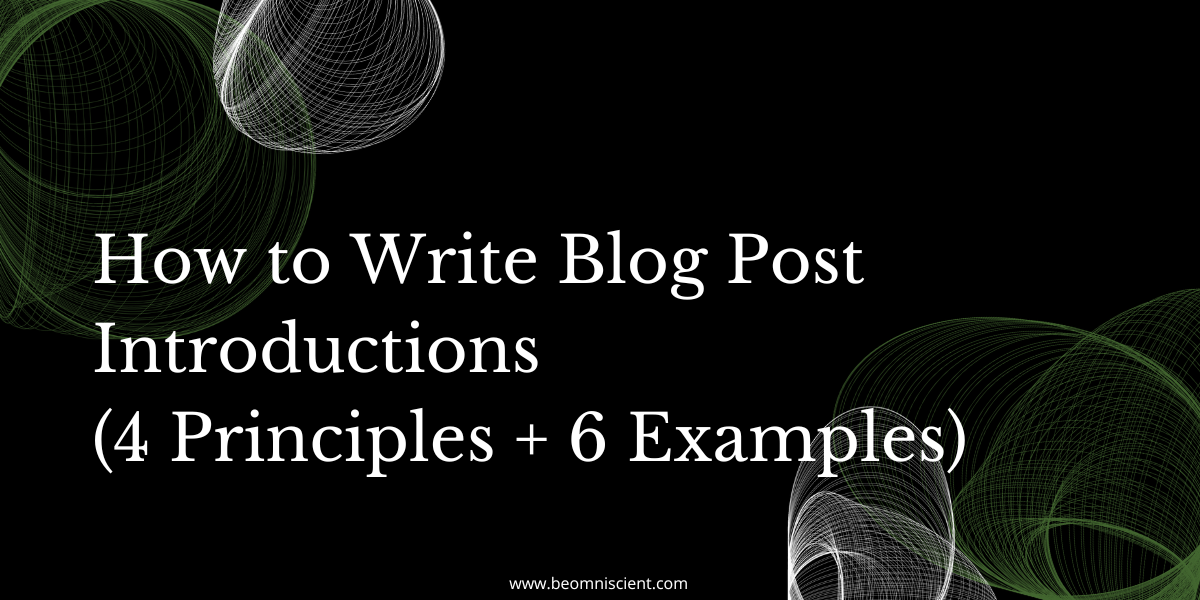
The success of an individual blog post hinges on its introduction.
Soon there will be billions of blog posts to choose from (there are already 600+ million)
In a land of limitless options, you only have a split second to capture someone’s attention and compel them to read the rest of the article.
Many content writers will craft a beautiful long-form blog post but flub the introduction, resulting in a missed opportunity and wasted effort.
In this blog post, I’ll explain what makes a good blog introduction and give several blog introduction examples to help inspire your efforts.
First, let’s cover blog post introduction principles (or click here to skip to blog introduction examples)
4 Blog Introduction Principles
- Capture attention
- State an uncontroversial subject with a complication
- Get to the point as quickly as possible
- Set the stage for the impending argument and structure
1. Capture attention
Marketing is largely a game of capturing (and keeping) attention. Attention is the scarce commodity we’re all fighting for.
Think for a second about all of the streaming options you have available to you: Disney Plus, HBO, Netflix, Amazon Prime, and on and on.
At a platform level, each of these needs to capture your attention to the extent that you’re willing to give it a chance and sign up.
After signing up, each platform has thousands of streaming options. Each individual show needs to capture your attention quickly enough that you’re willing to invest your time into watching the rest of the series.
The best example of this I’ve seen is the first episode of House of Cards, where (spoiler alert) Frank calmly strangles a dog that is suffering, revealing his cold and sociopathic nature.
Capturing attention in a blog post is difficult, but you do have some advantages:
- Those who came to your blog post did so with “intent,” either from search or from social or direct. You can infer this intent and lock them in with an initial statement that shows they’re in the right place.
- There are some proven copywriting frameworks (I’ll walk through later in the piece) for capturing attention and then moving down to interest and desire.
- People expect to strain a little bit in a blog post before reaching a moment of clarity. They typically have high motivation to learn, so they can fight through a little bit of murkiness.
Common ways to capture attention in blog posts include:
- Shocking statistics
- Stories that grab attention
- Relevant quotations
Capturing attention is part art and part science.
2. State an uncontroversial subject with a complication
I’m getting into the weeds a bit here, but there’s a great book on business writing called “The Pyramid Principle.”
In it, author Barbara Minto spends a whole chapter on effective introductions.
Her point is that the introduction should both capture attention and set the context for the argument to follow.
Her words:
“Limit the introduction to what the reader will agree is true. The introduction is meant to tell the reader only what he already knows. Sometimes, of course, you won’t know whether he already knows something; at other times, you may be certain that indeed he does not know it. If the point being made can easily be checked by an objective observer and deemed to be a true statement, then your reader can be presumed to ‘know’ it in the sense that he will not question its truth.”
Take, for example, my introduction above. I started it out with this sentence:
“In many ways, the success of an individual blog post hinges on its introduction.”
This is mostly uncontroversial, though the extent to which it’s true could be questioned. So I followed up in the next sentence (the complication):
“Soon there will be billions of blog posts to choose from.”
This presents both a statement and a logical “challenge” to the statement. Blog post introductions are important. There are many things people can pay attention to. Therefore, learn how to write a compelling blog introduction so that readers will choose your content.
From that, I can flow into the rest of the article explaining how to write compelling blog introductions.
3. Get to the point as quickly as possible
Tommy Walker, the founder of The Content Studio, calls verbose blog introductions “clearing your throat.” Most people use the blog introduction as a device to think through what they want to say, which is fine in draft mode.
But when published, this should be edited and chopped up.
When I wrote at CXL, Peep taught me that I could almost always cut a few hundred words from the introduction and just get to the point. Like, one or two sentences to lead someone into the piece. For example:

Shave the fluff. Get to the point.
4. Set the stage for the impending argument and structure
The point of the first sentence is to get them to read the second sentence. The point of the second sentence is to get them to read the third sentence. And the point of the blog post is to transfer knowledge.
Each step of the essay should set up the impending structure of the argument you hope to transfer. How this works in principle will depend on the information or argument you hope to transfer.
In my case here, I set up the piece to explore both the principles of a good blog introduction as well as a list of blog introduction examples. List posts are generally the easiest format of essay to write. You can even use an AI essay writer to get past writer’s block when writing complex structures, for instance, HIX EssayGPT will be a beneficial option.
For more complex structure examples, look to writers at The Atlantic as an example:

4 Good Blog Introduction Examples
Let’s cover a few great blog post introductions from various sources. I’ll also explain what I like about them.
1. The Atlantic
The Atlantic is admirable for so many reasons. People flock to The Atlantic for great storytelling and journalism, but they always start their pieces with a one sentence statement about the piece.
Take, for example, this piece on marriage.

While the eventual body of the essay contains a story-based intro, the initial introduction tells readers example what they’re going to achieve by continuing to invest time in reading it:

2. CXL
CXL is where I cut my teeth in content marketing. I (and the bloggers I worked with) were forced to write a comprehensive “best in the world piece,” but also to cut the fluff. It started in the introduction.
Take this wonderful piece by Shanelle Mullin for example. The essay is on a complex topic with many misunderstandings (“growth marketing”), but she cues up the piece brilliantly and simply.

She starts with historical context, agitates through a complication (the misunderstanding of the nature of “growth”), and promises value all in a few short paragraphs.
3. New Yorker
The New Yorker, known for its long form journalism and prose, is also effective at succinctly bringing you into the story.
They use a tactic similar to The Atlantic. While the eventual story may unfold gradually, they pull you in with a great headline and a one sentence summary of the piece that makes you want to continue reading:

4. HubSpot
HubSpot is a content marketing machine, so it’s no surprise they do introductions well.
Because they’re principally acquiring readers via search engine, they can infer a level of intent and understanding of the topic. The introduction doesn’t need to be eminently interesting, but instead has to immediately tell the reader “you’re in the right place for your answer.”

3 Bad Blog Introduction Examples
Now, let’s cover a few bad blog introduction examples and how they could be improved:
1. Alex Birkett’s blog
Yes, very meta. I’ll give you one from my personal site. I’m a rambler at heart. It’s hard for me to chop down my copy. I like writing 5,000 word blog posts. But that doesn’t always make it easy on the reader.
Take this example from my essay on brand awareness. The introduction is a mile long. You can tell I’m almost thinking out loud here:

How would I improve it? Chop out half the words and explain my deductive reasoning in the section below the introduction. Instead, I would write the introduction to be uncontroversial and introduce the problem.
“Everyone wants to improve brand awareness. The problem is no one has defined what “brand awareness means,” and everyone seems to have a different definition. In this piece, I’ll attempt to define “brand awareness” in a way that is useful across all marketing teams so we can have a shared metric and language to describe our goals.”
Easy and simple.
2. Towards Data Science
First, let me say: I love the Towards Data Science blog and have gotten tons of value from it.
But sometimes, the writing can be a bit convoluted. Here’s an example from a piece with the headline “machine learning for marketers” (great and simple headline).
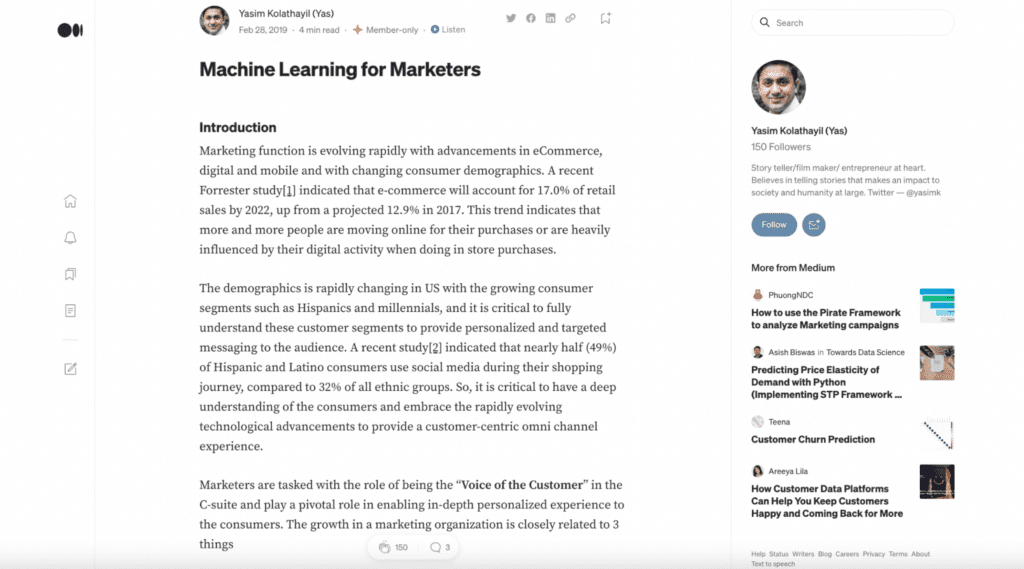
The introduction is just…long. Especially for an audience that doesn’t necessarily have the technical chops to understand why machine learning is important in the first place, they spend a ton of time on obtuse stuff like demographics, trends, statistics, and voice of customer.
All of these could be great arguments in body of the essay itself, but the introduction doesn’t compel me to keep reading.
I’d shorten it up a ton:
The proliferation of machine learning has made it much easier to accomplish tasks that just a few years ago were time consuming and expensive. Marketers especially can benefit from machine learning, but it’s not easy to know where to start. In this essay, we’ll cover X ways marketers can use machine learning to improve efficiency and ROI and get more done faster.
3. Writesonic
One ironic bad blog post introduction is by Writesonic in their article on…blog post introductions.
The writing is fine. The rest of the essay is great. There are even some nuggets of story and hooks that make you want to learn.
But it’s just. too. long.
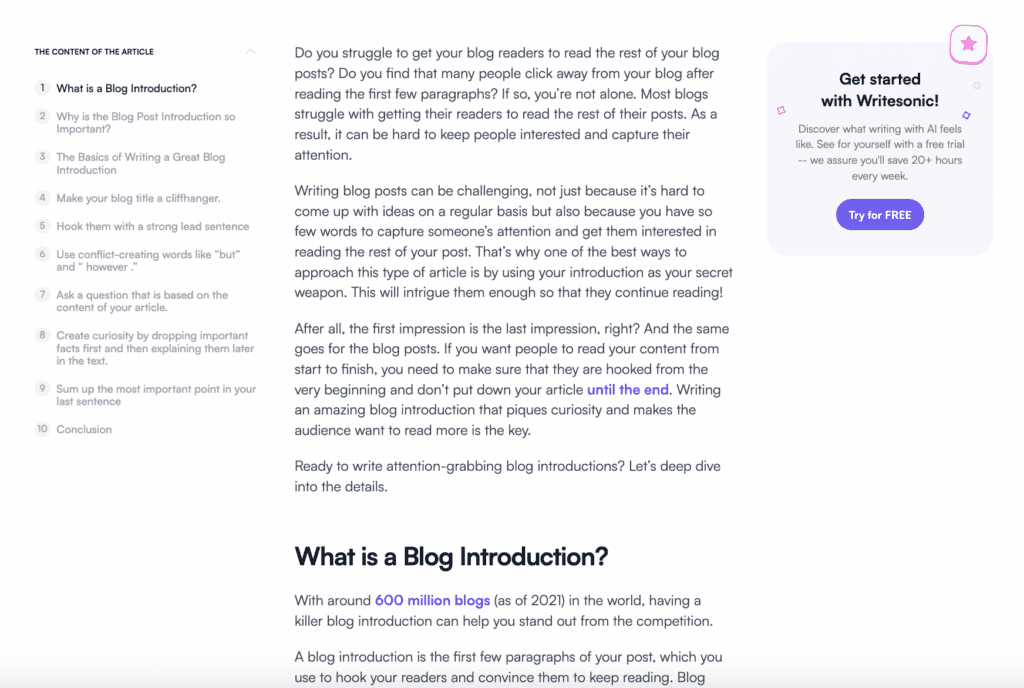
I’d shorten this bad boy quite a bit. Create a central thesis. Agitate the problem to create a hook. Then explain how you’ll meet the promise readers want to achieve.
Let me also say quickly that Writesonic is a great tool. I’ve written about Writesonic alternatives as well as Jasper vs Writesonic in the past. Still love them.
4 Tools to Help Write Blog Introductions
- Jasper AI
- Copy AI
- Hypotenuse AI
- Copywriting Frameworks
1. Jasper AI
Jasper is an AI writing tool that helps you write better blog introductions through artificial intelligence (built on OpenAI). It does this by analyzing your introduction and, through their various templates and prompts, improving it on various dimensions.
You can also use Jasper to generate ideas for introductions.
Here’s how I could have used Jasper to generate an intro idea quickly:
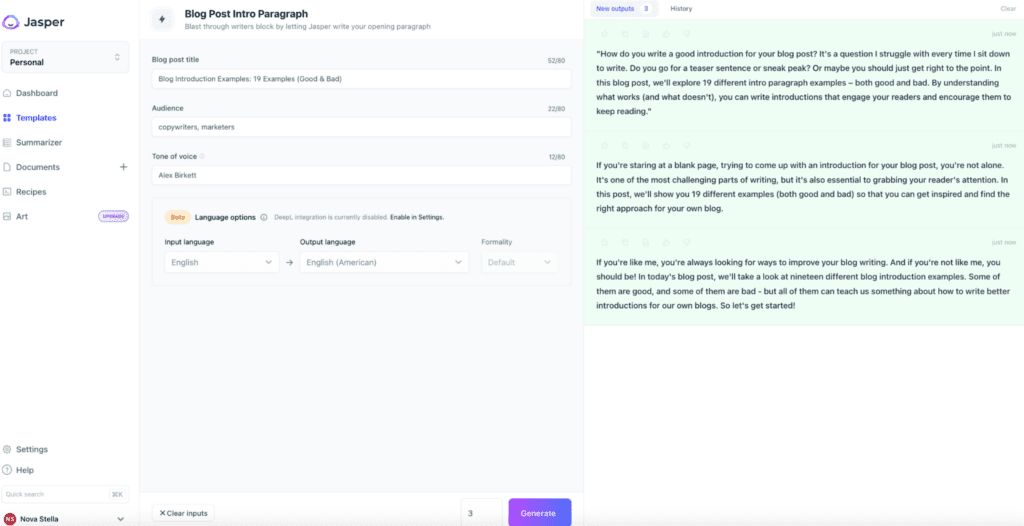
Outside of introductions, Jasper is an incredible all-purpose content writer. You can use it to write a blog in its entirety. I often use it to outline a blog post before I begin writing it, as well as to chop up and improve my writing at the paragraph level.
2. Copy AI
Copy AI is another AI copywriting software. Similar to Jasper, it is built on OpenAI. But it relies much more on pre-built templates than the open format and command structure Jasper uses.
One of my favorite free tools they have for writing blog introductions is their paragraph rewriter:
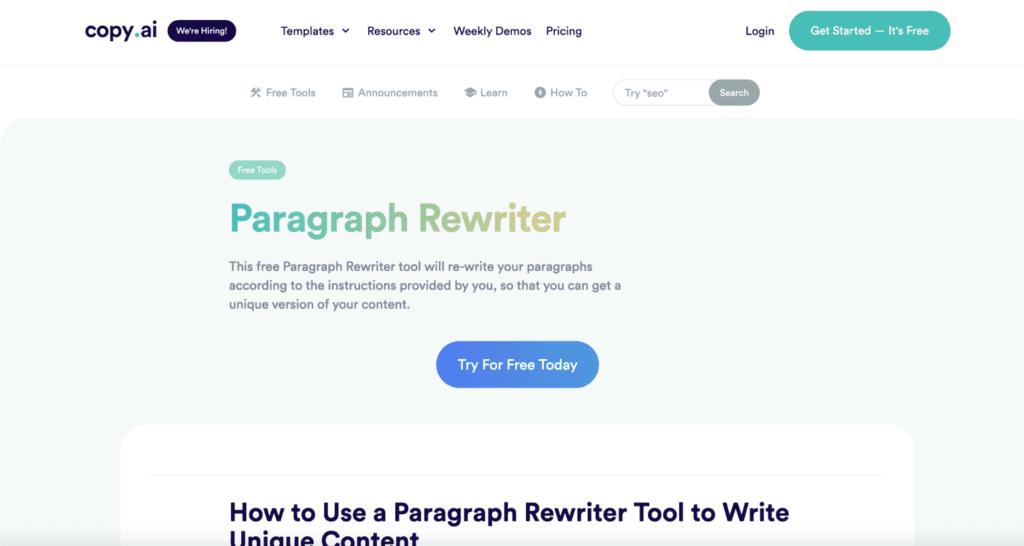
3. Hypotenuse AI
Hypotenuse AI is another AI writing assistant. This one is great at bulk copywriting and spinning, so you can write the same introduction 100 different ways.
While this isn’t my preferred way to write an introduction, it can definitely help if you’re engaging in high scale content creation.
4. Copywriting Frameworks
The most effective tool for copywriting might simply be understanding and embedding copywriting frameworks into your blog introductions.
There are many copywriting frameworks, including:
- AIDA (attention – interest – desire – action)
- PAS (problem – agitate – solution)
- BAB (before – after – bridge)
And probably 100 more.
Different copywriting frameworks can be used in different contexts. For example, AIDA is a great framework for sales copywriting, but PAS might be simpler to use in a quick introduction. For example, one could write:
Writing blog introductions is one of the most difficult parts of writing content. If you’re able to write a compelling blog introduction, you can improve your SEO, conversion rates, and reader satisfaction. In this post, I’ll teach you three easy frameworks for writing blog post introductions.
It opens up with the key problem. Then it agitates that problem by showing the world that could exist if the reader could write great blog introductions. Finally, I give a solution (read the rest of this post so you, too, can write great blog post intros).
Conclusion
Blog introductions are important for setting the tone and structure of your article. A great introduction will capture attention, set up the argument, and be short and to the point.
There are many tools that can help you write great blog introductions like some of the best copy AI alternatives for 2023, including AI writing assistants, copywriting frameworks, and more.
By following the tips in this post, you’ll be able to write introductions that’ll improve your SEO, drive traffic, increase conversion rates, capture the reader’s trust and attention, and more.
Obviously, there are nuanced style components to doing this that you’ll have to make your own. You can’t simply follow a formula. Write like you talk. Establish presence that no one else can mimic.
But do so in a structured way, so you can set up the blog post in a proper way where the reader is anticipating your answer to the question they’re asking.
What are your favorite tips for writing great blog introductions? Let me know in the comments below.



